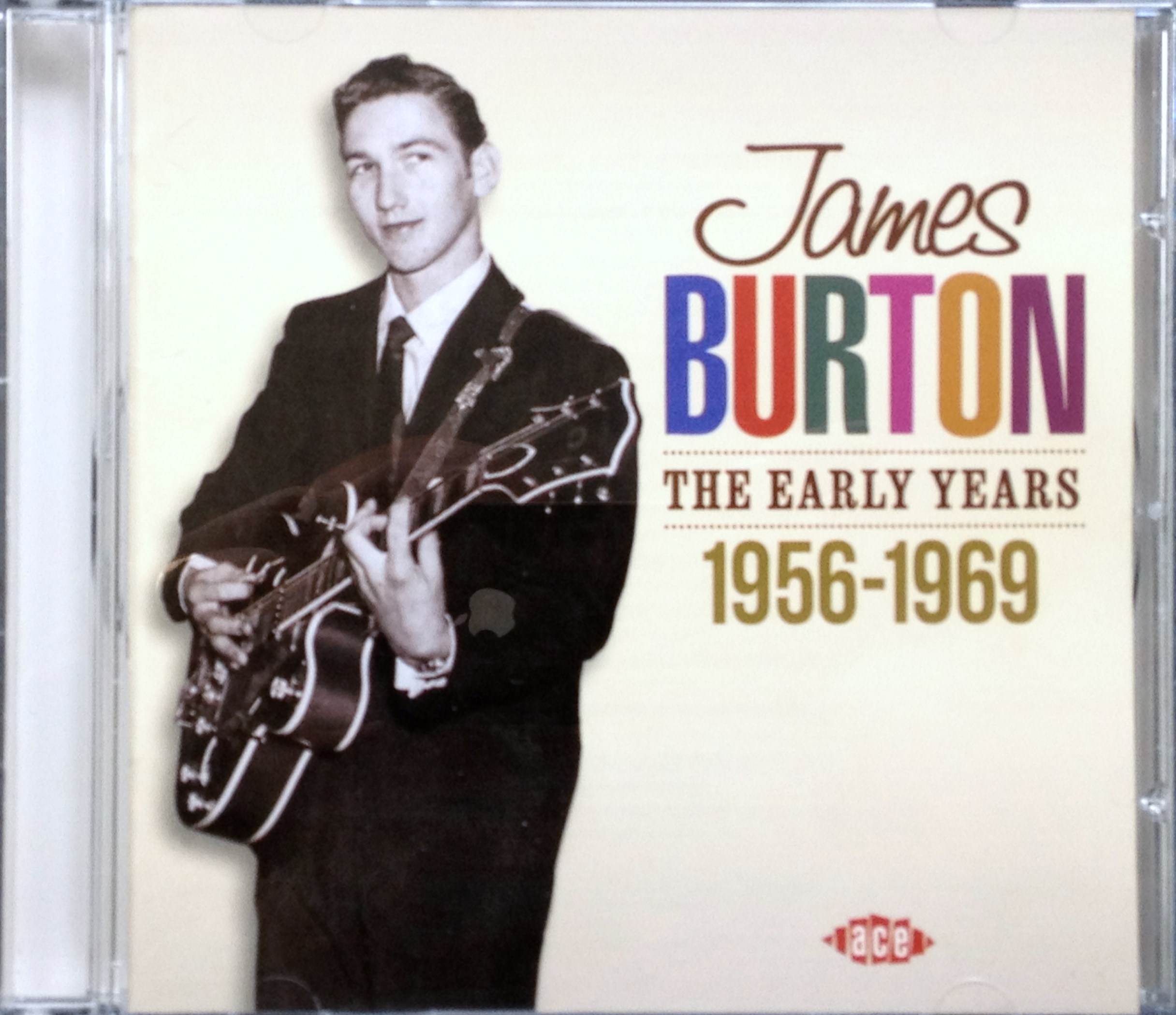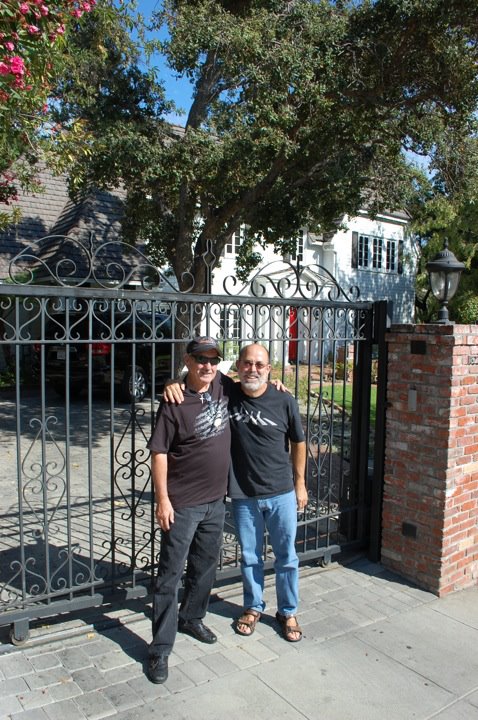Last fall, in conjunction with a celebration of what would have been Buddy Holly’s 75th birthday, I found myself riding around Los Angeles with my guitar hero, James Burton. James was in town because I’d arranged for him to partner with Lyle Lovett and join a who’s who of artists playing a concert in Buddy’s honor. Over the course of the next few days, I would attend rehearsals at which I’d stand slack jawed while watching James casually toss off one completely different, stinging, brilliant solo after another. At the concert (about which I wrote here), filmed for presentation on PBS, I’d hear Lyle introduce James by announcing, “It’s my honor to bring up one of my guitar heroes.” But, for now, the man whom Keith Richards inducted into the Rock and Roll Hall of Fame is serving as my chauffer and tour guide.
I found myself riding with James when he called my hotel and asked, “John, what are you doing? How about I come by, pick you up, and show you around.” First stop was “Ricky’s house.” Yep, the home of the Nelson family where James shared a bedroom with Ricky while living with the family and appearing in the 1950s TV show. Second stop was a surreal and funny visit to Guitar Center, where James walked about as young shredders stared unknowingly at the old man invading their turf while seeking to impress all with their mastery of “Stairway.”
But, things got even more interesting when James pulled up and stopped in front of Capitol Records Recording Studios on Vine Street in Hollywood. “You know,” said James, “I still remember when I recorded here with Nat King Cole.” This would be the first of dozens of stories recounted over the next several hours in front of various recording studios around Los Angeles (yes, I recorded it all). I’d known about James playing with the likes of Ricky Nelson and Elvis and that he put the “hot” in Emmylou Harris’s “Hot Band.” I’d even known that he was part of the “Wrecking Crew,” that loose association of musicians who were ubiquitous in LA’s recording studios in the 1960s and 1970s. But, until our tour of LA’s most illustrious recording locations, I’d had no idea of just how central a role he had played in defining the very sounds of rock, pop, and country music. The stories covered sessions with the Sinatras (Frank and Nancy), Elvis, Ricky Nelson, Buffalo Springfield, the Byrds, the Flying Burrito Brothers, Gram Parsons, the Everly Brothers, EmmyLou, and, well, everybody. By day’s end, I’d arranged to spend a lot more time with James and I’d developed a serious hankering to hear an overview of his studio work.
My wish has been granted. Well, halfway. Ace Records, the UK compilation specialists, have released James Burton: The Early Years 1956-1969. It’s the first of two volumes designed to illuminate the seminal guitarist’s body of work. It’s a treasure trove of Americana essential to music librararies not only of guitarists, but of all fans of recorded sound. Nicely packaged, with fine liner notes summarizing James’s career, it contains 28 tracks that span from James’s 1956 recording debut through his 1969 performance on Buddy Cagle’s aptly titled The Guitar Player (the Ballad of James Burton).
The collection includes a number of musical and music-production styles, resulting in an assemblage of tunes that are not of uniform quality. But, this only serves the mission by demonstrating that James’s talent transcends musical context. From the first notes with a forgotten Carol Williams in 1956 on Just for a While, a 15 year old James emerges as a nearly fully formed artist. He’s playing what is to become his trademark Telecaster and, astonishingly, demonstrates a maturity that modern players twice his age would benefit by emulating. He comes out blazing on his solo, but then lies back before he risks overshadowing the song and vocal artist. It will take a few years before that staccato “chicken pickin’” will emerge, but he’s already mastered most of the other techniques that would soon make him a legend: the use flatpick and fingers to sculpt the nearly impossible, angular yet fluid lines, and crazy double string bends.
Actually, “soon” is an understatement. Modern scientists who have looked to the neutrino in their search for an object that moves so fast as to violate Einstein’s theory of relativity could have forsaken the environs of the large hadron colliders and simply studied James’s career. Consider, for example, Suzy Q, on which our young guitar hero gifted (James never got co-writing credit for his contribution) singer Dale Hawkins the memorable lick that would help to put James on the Louisiana Hayride where he’d meet Ricky Nelson and, within a year land at “Ricky’s house.” Then, at the ripe old age of 17, he’d get to work helping to define the sound of American music.
The compilation is far from definitive, but it couldn’t be unless it contained a hundred CDs. It does cover all of the bases. Documenting the Ricky Nelson period are My Babe, Don’t Leave Me This Way, Stop Sneakin’ Around, and Blood from a Stone. The omission of the classics like Hello Mary Lou and Traveling Man, which feature equally classic guitar solos, seems curious. But, it’s good to hear James’s stellar work on lesser known tunes. And, the collection contains some really pleasing surprises such as Fireball Mail and Daisy Man waxed with fellow Wrecking Crew teammate Joe Osborn under the moniker, “Jim and Joe.” There are also cuts featuring James on Dobro and tunes with James playing with the likes of the Everly Brothers, Glen Campbell, and Merle Haggard. A real standout is James’s blistering version of Merle Travis’s Cannonball Rag, which James performed on the 1950s television program “Town Hall Party” when Travis was unable to appear.
This collection is not perfect. My chief complaint is about the arrangement of the tracks. The first of 28 cuts is 1957’s Suzy Q, the 27th is 1956’s Just For A While, and the collection closes with 1962’s Tryin’ To Be Someone (billed to “David and Lee,” with “David” being David Gates who would later star in the band, Bread). In between those cuts, the timeline zigs and zags. I suppose one might switch an MP3 player into shuffle mode and hope that the gods of chance eventually take mercy and arrange the tunes in chronological order. As is, the package fails to coalesce as an artistic whole because it’s difficult to form an impression of either James’s evolution or the direction of pop music over the course of the years that the compilation spans. This, though, is a small complaint when each track presents its own delights.
Volume 1 stops in 1969, just before James would meet Gram Parsons, hang with the Flying Burrito Brothers, get that Hot Band up and running and eventually take his rightful place at the side of The King. Based on the stories I heard while riding shotgun with James around LA, volume two should be at least as revelatory as volume one.
Long live The King of Sidemen.

